-

人教版新目标初中英语七年级下册I want to be an actor教案2篇
三、教学建议第一课时:1. Lead in (Vocabulary)A) Before class, teacher should collect some pictures of working places. For example: Bank, TV Station, Restaurant, Police Station, Hospital ...B) In class, show students the pictures (PowerPoint, OHP). Ask students to tell the name of the working places and the name of the jobs.Shop assistant, doctor, actor, reporter, police office, waiter, bank clerk, studentC) Do exercise 1a and 3a.2. Bingo GameAsk groups of students to make up pairs of cards with a job on one and the related workplace on the other. For example, waiter / restaurant, teacher / school, doctor / hospital. Encourage students to use both the job / workplace combinations in the book and the ones that students came up during class discussions. Be sure they have twice as many sets of cards as there are students in the group. They can make two sets of cards for a single job / workplace, if necessary. Then have each group mix up its set of cards and hand their cards out in random order. Each time a student gets a pair of cards that match, he or she can lay these cards down. The goal is to have no cards in your hand at the end.3. Task OneA) Ask students to work in pairs and ask the partner what does he / she want to be in the future.e. g. :What do you / does he / does she want to be?I want to be a.Why?Because it's (adj).B) Vocabulary: Section B, 1a4. Homework 1.2.

人教版新目标初中英语七年级下册It’s raining教案2篇
1 Each group choose one place to describe and what you are doing in it Choose one place, and describe what they are doing 2 Move around the room and give suggestions Talk about it and write it down 3 Ask one to show their works and act it Choose one of each group to make a report 4 Evaluate the best group and the best reporter Choose the best one Homework Ask your friends their ideal place and write about it教学反思:新课程标准中强调学生在课堂中的主体地位,在综合课中他们的主体地位就更加突出。在各个活动中给不同程度的学生不同层次的任务,让各层面的学生都有表现发挥的机会,从而产生对英语的兴趣。使用照片图片多媒体来辅助教学,效果更好。同时让了解其他国家风景,风俗的同学介绍ideal place,增加学生的背景知知识,实现跨学科交流的目的。教案点评:采用任务型教学模式,在各个活动中给不同程度的学生不同层次的任务,让各层面的学生都有表现发挥的机会,从而产生对英语的兴趣。使用照片图片多媒体来辅助教学,效果更好。让了解其他国家风景,风俗的同学介绍ideal place,增加学生的背景知识,实现跨学科交流的目的。

人教版新目标初中英语七年级下册Why do you like koalas教案2篇
单元整体说明(一)单元教材分析本单元的核心话题是描述动物和表达个人喜好,以及句式why do you like…? Because…。这也是本单元的教学重点。通过本单元的学习,学生应能较流利地运用所学词汇和句型描述动物,表达个人喜好。(二)单元知识结构1.词汇动物名称 tiger, elephant, koala, dolphin, etc.词汇描述性形容词: smart, cute, ugly, clever, shy, etc.国家名: Australia, South Africa2.句型Why do you like koala hears? Because they are cute.Where are pandas from? They're from China.What animals do you like? I like dolphins.(三)单元整体目标1.Master the vocabulary2.Master and use: Why do you like koalas? Because they am cute.Where are pandas from? They're from China.What animals do you like? I like dolphins.(四)单元教学重难点一览(五)单元学情分析学生此前已经学过由why, where, what 引导的特殊疑问句句型,具有了学习本单元知识的认知前提。形形色色的动物能激发学生的好奇心,产生了解它们的欲望,这有利于本单元知识的教学和学生学习兴趣的培养。

人教版新目标初中英语八年级下册What should I do教案2篇
说明:在帮Li Lei提建议的同时,教育学生如何学好英语。第三课时教学目标1. 语言目标:a) 词汇: Original, in style, haircut, the same as.b) 语言结构:My friend wears the same clothes and has the same haircut as I do.2. 能力目标:大多数学生能够谈论自己喜欢哪种服装,提高查找信息的能力。3. 情感目标:学会如何与朋友相处,要有自己对时尚的看法。教学重点掌握一些重要词汇。教学难点学会谈论问题,并能提出书面建议。◆教学突破首先针对Erin的问题,提出个人的建议,模仿2c部分的对话展开双人交际Pair-work;听老师诵读3a部分的信件,并找出LEFT OUT的问题所在;学生完成3b部分的内容,给Left Out提出书面的建议;学以口头形式提出自己目前存在的某个问题,讲给大家听,让同学们给自己提出一个建议,并作笔录;学生两、三个人分成一组,随意性地进行口语交际,谈论P14的第4部分的某个问题,相互交换意见。

人教版新目标初中英语八年级下册If you go to the party, you’ll have a great time教案2篇
区分宾语从句、定于从句和状语从句宾语从句和状语从句,都叫做主从复合句。宾语从句主要是中考必考的,是初中阶段必掌握的从句,宾语从句主要是掌握三要素,所谓宾语从句,就是宾语在主从复合句当中充当宾语的一个句子,叫做宾语从句。主句的谓语动词是及物动词,后面如果是词或者是短语的话,是简单句,如果是句子的话,肯定是宾语从句。I know that he good at English.就是宾语从句,三要素,一要素是要注意连词,连词一共学了三类连词,一类连词是that口语当中可以省略,就像刚才说的那一句,I hear he is good at English.还有疑问代词、疑问副词,how where when,疑问代词、疑问副词。还有一类连词weather是否的意思,不是状语从句当中的如果,这一定要和如果区分开,这是是否。I don't know if he interested at English。宾语从句要注意if是连词。第二要素是语序,要用陈述举语序。比如说你家有几口人,我们都说How many people are there in you family?但是这是简单句,一旦说成宾语从句,你可以告诉我你家有几口人吗?Could you tell me how many people there are in you family ?

人教版新目标初中英语八年级下册It’s a nice day, isn’t it教案2篇
"Hello! Welcome to English class! Introduce yourself. Meet your new classmates." That's what the teacher says. What do you say? "Oh no!" It can be difficult talking to new people. But it can be fun, and you can make friends. How do you do it? Make small talk. Small talk is polite conversation. "Wang Nan is a great pingpang player, isn't she?" "I'd love to meet her, wouldn't you?" "It's been raining a lot, hasn't it?" Tag questions are a form of polite speech. To make small talk successfully, you should know how to make them. You should also know what topics to talk about. Try to learn this unit carefully. The next time you're in English class, you'll find out. Making small talk's easy, isn't it? (“你好!欢迎你!请做一下自我介绍。认识一下你的新同学。”通常在课上老师会这样说。你会说什么呢?“噢,不!”与陌生人谈话太困难了。但是这也很有意思,并且你还能交到朋友。你该怎么做呢?闲聊。闲聊指得是礼貌的对话。“王楠是一个很棒的乒乓球运动员,不是吗?”“我希望自己能认识她,你呢?“今年的雨水很多,不是吗?”反意疑问句是一种礼貌用语。为了使得谈话成功,你应该知道怎样去进行闲聊。你还应该知道与不同的人该谈论什么样的话题。认真的学习这个单元吧,下次在英语课上,你会发现与大家展开谈话是一件很容易的事情,不信我们来试试。)

人教版新目标初中英语八年级下册He said I was hard-working教案2篇
This activity introduces some new vocabulary and provide oral practice using the target language.Task 1 . Ask four students to stand in front of the class, and the teacher asks them the following questions as a reporter.1.What are you going to do when you grow up?2.What are you going to do next week?3.What are going to do after school?The students will give different answers, then ask a good student to report what they said.I am going to e a doctor.What did she say?----------She said she was going to be a doctor.I am going to have a party on Friday night.What did he say?-------He said he was going to have a party on Friday night.I am going to do my homework.What did she say ?------ She said she was going to do her homework.I am going home after school.What did she say?-----She said she was going home after school.Say In this unit we are going to learn to use words like to report what someone said.Task 2. Read the instructions. Then ask a student to read the four questions. And write the words on the Bb. Explain what soap opera is.Task 3. Ask the students to Look at the pictures, point out the TV screens in the picture. Ask one girl to read what Marcia said.What did Marcia say? She said She said she was having a surprise party for Lana on Friday night. Repeat the other pictures in the same way.Activity3. Listen and number the pictures in activity 1a.

人教版新目标初中英语八年级下册How long have you been collecting shells教案2篇
Step Ⅱ Show the new words on the screen and teach the new words. Read the new words to students and ask them to repeat.Step Ⅲ 3aThis activity introduces new vocabulary and provides reading practice using the target language.In this activity first look at the four pictures.T: What can you see in the pictures?Ss: Four snow globes.T: Right. There are four snow globes in the pictures. And what are they?Ss: They are a monster, two polar bears, two penguins and a birthday cake.Write these words on the blackboard: snow globe; monster; polar bear; penguin and birthday cake. Read them to the class and ask students to repeat each one. Make sure students understand each word.Use a computer to show the E-mail message on the screen and read the message to students.Get students to read the e-mail on their own, and then draw lines connecting each snow globe and its description.Correct the answers.AnswersA line should connect each snow globe picture with the words that describe it in the letter.Step Ⅳ 3bThis activity provides writing practice using the target language.First review Activity 2a on Page 47.Then ask students to complete the message according to Activity 2a.Some partial sentences are given to students. Write about one person's collection.When students work, walk around the room checking the progress and offering help as needed.When they finish, ask some students to read their messages to the class.

人教版新目标初中英语八年级下册What were you doing when the UFO arrived教案2篇
(一).知识方面: 1.培养学生能运用过去进行时来描述、谈论过去某个时间正在发生的事情或动作的意识和能力,能就过去某个时间正在发生的动作做出正确的描述。 2.培养学生的想象力和角色扮演的合作能力。 3.培养学生讲述过去发生的事情经过的能力。能正确运用一般过去时来讲述故事。 (二).技能方面: 1.本单元的语言目标是Talk about past events and tell a story(谈论过去的时间和讲述一个故事),围绕这一目标,要涉及句型: What were you doing when the UFO arrived? ----I was sitting in the barber’s chair. The barber was cutting my hair. 因此必须学习standing、studying、cleaning、sleeping、cooking、making、eating、cutting、等表示地点的词,以便为上述句型提供语言材料。2.学习过去进行时的有关知识。Was/were+现在分词,是该时态的表达式。 3.在学习过程中,要区分The boy was walking down the street when the UFO landed.和While the boy was walking down the street, the UFO landed.这两种由when和while引导的状语从句的句型结构。注意它们的不同。

人教部编版道德与法制五年级下册弘扬优秀家风说课稿
你知道这些名言警句出自哪里吗?从中你可以学到什么?俭以养德,静以修身。——诸葛亮《诫子书》我们要养成节俭的美德,不铺张浪费。非淡泊无以明志,非宁静无以致远。——诸葛亮《诫子书》一个人须恬淡寡欲方可有明确的志向,须寂寞清静才能达到深远的境界3.3百年革命家国情怀同学们,我们今天的美好生活,是许多烈士用鲜血换来的。书中摘录了一些仁人志士写给家人的书信。我们一起来读一读,边读边思考,你从中体会到了哪些优秀家风?热爱祖国,报效祖国。教师小结:在培育良好家风方面,先辈们为我们做出了榜样,让我们学习先辈,传承良好家风。4.活动园对长辈做一次访谈,了解家风,并在班中交流分享。(三)教师总结:家庭就像社会中的细胞,每一个小家的幸福共同构建起一个和谐的社会。每一个家庭的优秀家风,汇聚成中华民族的家风。无论时代如何变化,优秀家风都是国家发展、民族进步与社会和谐的基础。作业写作一篇《我的家风故事》,下节课分享讨论。
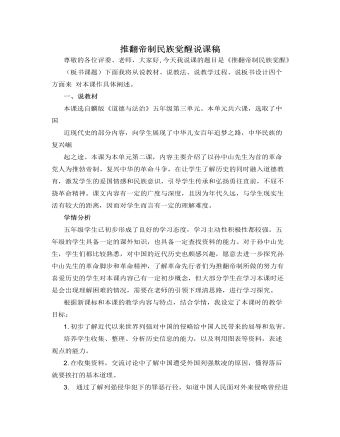
人教部编版道德与法制五年级下册推翻帝制,民族觉醒说课稿
孙中山先生一生都在为推翻帝制,推进民主革命,实现中华民族的伟大复 兴而努力,他是一位伟大的革命先驱,值待我们每个人的尊敬与怀念。 活动三:感受孙中山的革命精神(一)学习名言1、出示孙中山先生的名言,指名学生朗读。2、请学生来说说名言的含义。3、老师帮助解读,引导学生体悟孙中山先生的革命精神。4、请学生结合孙中山先生的伟大精神,说说对自己的学习生活的启示。5、齐读名言。(二)学习链接资料1、出示课文中链接资料,学生默读资料。2、讨论:说说我们国家目前的巨大变化,畅想祖国的美好未来。3、教师小结今日中华民族的伟大复兴与革命先辈们的不断探求救国救民之路,奋勇抗争推翻帝制是分不开的,让我们牢记历史,以孙中山等革命先驱为榜样,为祖国的美好未来努力奋斗!
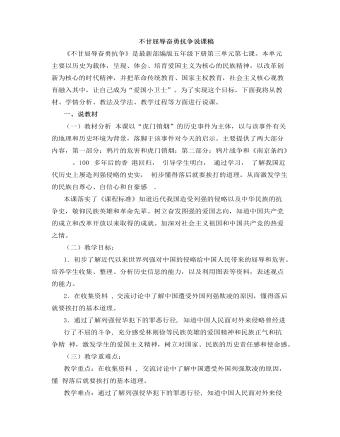
人教部编版道德与法制五年级下册不甘屈辱,奋勇抗争说课稿
师小结:气势恢宏的建筑,价值连城的奇珍异宝,不知凝聚着古今中外多 少能工巧匠的智慧和心血,因此,圆明园被誉为“万园之园”。活动二:惋惜圆 明园的毁灭1、令人遗憾的是,令人悲愤的是,这“万园之园”竟被一把无情的火烧成 了灰烬,那么,火烧圆明园是在什么情况下发生的呢?让我们看看当时的情景。师:这把无情的大火把我们引以为豪的“万园之园”烧成了一片灰烬,毁 于一旦。——板书:毁于一旦2、想一想,当时的圆明园为什么会被掠夺、焚烧?[ 出示课件 ] 南京条约的内容,用一个词来形容自己看到条约的心情。3.师:是的,只要是有良知的中国人看到这份条约都会感到无比的愤怒。 可是还有比这更令人愤怒的事,1900 年,八国联军侵入中国,你们知道他们都 干了些什么吗?4.圆明园如果存在于现在的中国,它还会遭到掠夺吗?为什么?(不会,因为中国强大了。)从哪可以看出中国强大了?(生自由说)
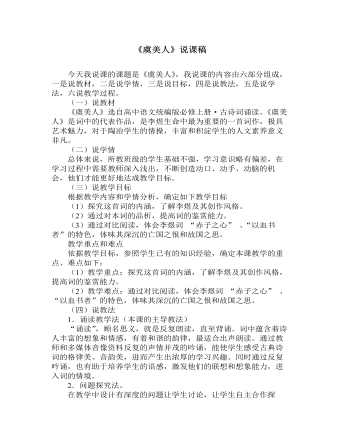
古诗词诵读《虞美人(春花秋月何时了)》说课稿 2021-2022学年统编版高中语文必修上册
(一)说教材 《虞美人》选自高中语文统编版必修上册·古诗词诵读。《虞美人》是词中的代表作品,是李煜生命中最为重要的一首词作,极具艺术魅力,对于陶冶学生的情操,丰富和积淀学生的人文素养意义非凡。(二)说学情总体来说,所教班级的学生基础不强,学习意识略有偏差,在学习过程中需要教师深入浅出,不断创造动口、动手、动脑的机会,他们才能更好地达成教学目标。(三)说教学目标根据教学内容和学情分析,确定如下教学目标(1)探究这首词的内涵,了解李煜及其创作风格。(2)通过对本词的品析,提高词的鉴赏能力。(3)通过对比阅读,体会李煜词 “赤子之心” 、“以血书者”的特色,体味其深沉的亡国之恨和故国之思。
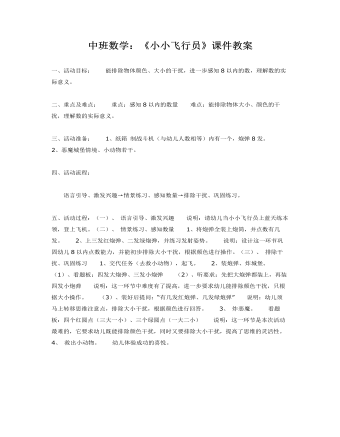
中班数学:《小小飞行员》课件教案
二、重点及难点: 重点:感知8以内的数量 难点:能排除物体大小、颜色的干扰,理解数的实际意义。三、活动准备: 1、纸箱制战斗机(与幼儿人数相等)内有一个,炮弹8发。 2、恶魔城堡情境、小动物若干。四、活动流程: 语言引导、激发兴趣→情景练习、感知数量→排除干扰、巩固练习。五、活动过程:(一)、语言引导、激发兴趣 说明:请幼儿当小小飞行员上蓝天练本领,登上飞机。
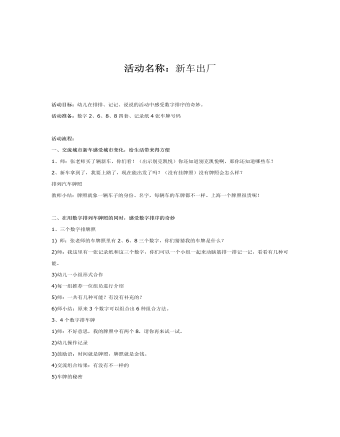
大班数学:新车出厂课件教案
活动准备:数字2、6、8、8四套、记录纸4张车牌号码 活动流程:一、交流城市新车感受城市变化,给生活带来得方便1、师:张老师买了辆新车,你们看!(出示别克凯悦)你还知道别克凯悦啊,那你还知道哪些车?2、新车拿到了,我要上路了,现在能出发了吗?(没有挂牌照)没有牌照会怎么样?排列汽车牌照 教师小结:牌照就象一辆车子的身份、名字,每辆车的车牌都不一样。上海一个牌照很贵呢!
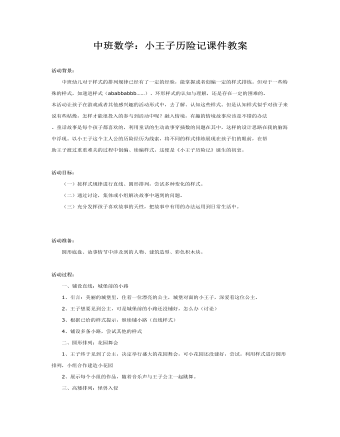
中班数学:小王子历险记课件教案
活动目标: (一)按样式规律进行直线、圆形排列,尝试多种变化的样式。 (二)通过讨论,集体或小组解决故事中遇到的问题。 (三)充分发挥孩子喜欢故事的天性,把故事中有用的办法运用到日常生活中。 活动准备: 圆形底盘、故事情节中涉及到的人物、建筑造型、彩色积木块。 活动过程: 一、铺设直线:城堡前的小路1、引言:美丽的城堡里,住着一位漂亮的公主,城堡对面的小王子,深爱着这位公主。
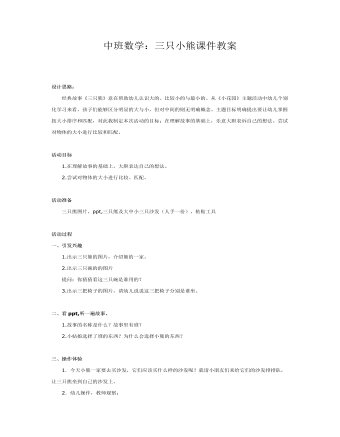
中班数学:三只小熊课件教案
活动目标1.在理解故事的基础上,大胆表达自己的想法。2.尝试对物体的大小进行比较、匹配。 活动准备 三只熊图片,ppt,三只熊及大中小三只沙发(人手一份),粘贴工具 活动过程一、引发兴趣1.出示三只熊的图片,介绍熊的一家。2.出示三只碗的的图片 提问:你猜猜看这三只碗是谁用的?3.出示三把椅子的图片,请幼儿说说这三把椅子分别是谁坐。
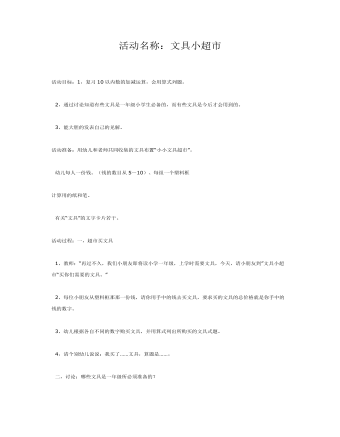
大班数学:文具小超市课件教案
2,通过讨论知道有些文具是一年级小学生必备的,而有些文具是今后才会用到的。 3,能大胆的发表自己的见解。活动准备:用幼儿和老师共同收集的文具布置“小小文具超市”。 幼儿每人一份钱。(钱的数目从5~10)、每组一个塑料框计算用的纸和笔。 有关“文具”的文字卡片若干。
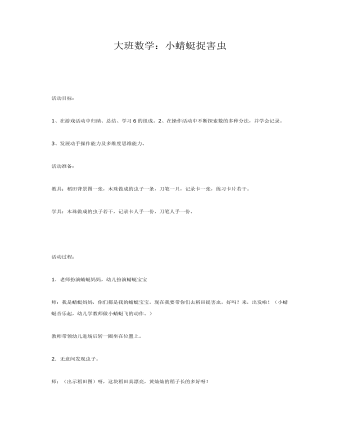
大班数学:小蜻蜓捉害虫课件教案
2、在操作活动中不断探索数的多种分法,并学会记录。3、发展动手操作能力及多维度思维能力。活动准备:教具:稻田背景图一张,木珠做成的虫子一条,刀笔一只,记录卡一张,练习卡片若干。 学具:木珠做成的虫子若干,记录卡人手一份,刀笔人手一份。
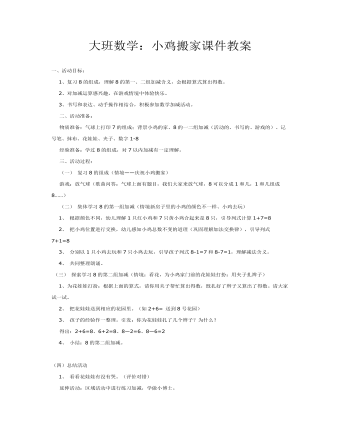
大班数学:小鸡搬家课件教案
2、对加减运算感兴趣,在游戏情境中体验快乐。 3、书写和表达、动手操作相结合,积极参加数学加减活动。 二、活动准备: 物质准备:气球上打印7的组成;背景小鸡的家、8的一二组加减(活动的、书写的、游戏的)、记号笔、抹布、花娃娃、夹子、数字1-8 经验准备:学过8的组成,对7以内加减有一定理解。 三、活动过程: (一)复习8的组成(情境——庆祝小鸡搬家) 游戏:放气球(歌曲问答:气球上面有题目,我们大家来放气球,8可以分成1和几,1和几组成8……)

